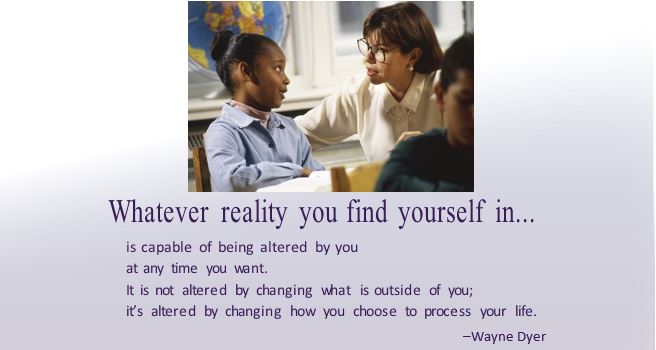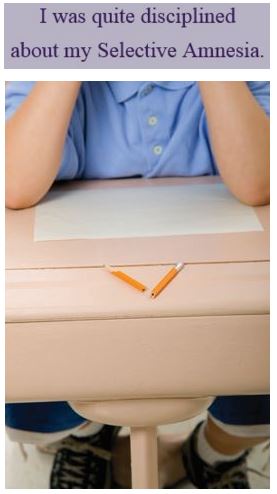
Get Honest with Yourself
The most important and courageous thing we can do to really make a difference is to look at what we have decided is wrong with the individual that we are having the most difficulty with.
What we have determined is wrong with them, i.e., the label, becomes a substantial part of our attitude toward them. It’s true. It’s real. We are not responsible for their choice in behaviors, but their behaviors will in fact be affected by our energetic interaction with them. The great news is that as we become more conscious of the effects of attitudinal energy, we can have a greater degree of influence in getting a different outcome than we’ve been getting.
For now, you may be thinking, “Well, why don’t they just do what they know they should be doing in the first place? Why does this have to be up to me? I’m not the one behaving badly!”
True, and yet, as long as you have “an attitude” about “them,” you are energetically engaged with them. You, like they, are locked into judgment and resistance, making it a part of your experience. Whether you meant for your attitude to have this kind of impact or not, it does!
To change the experience, you must interrupt yourself at the thought level, change your thinking and therefore your attitude about the experience. You have an attitude about this. You just do. It’s really okay, and it’s really that simple. If you are to make a positive difference, you must be self-effacing and compassionate with yourself first so you can extend it to others.
When a class comes along that has more square pegs than round holes, and educators mistakenly keep trying to fit them all into round holes, the students are often labeled in ways that are counterproductive.
 This creates miserable discourse for everyone involved. Expectation is the key to turning things around, and that is why my second favorite TurnAround Specialist technique is to get: Selective Amnesia!
This creates miserable discourse for everyone involved. Expectation is the key to turning things around, and that is why my second favorite TurnAround Specialist technique is to get: Selective Amnesia!
Crazy Josh & the Biggest, Baddest 6th Grade Class
I had just been hired at my second school, in what would be my third year of teaching. Because I had received numerous accolades in my first two years, successfully teaching behaviorally challenging children, I had earned a reputation for being a “high-functioning disciplinarian.”
Consequently, I was offered a new teaching position to take on the class that had been labeled by the faculty and staff as “the biggest, baddest sixth grade class.” Although the administrator interviewing me may have assumed that I was a traditional authoritarian disciplinarian, in fact, I didn’t agree with or use that model at all.
These students allegedly behaved so badly that they maximally stressed out and frightened every teacher who had worked with them since kindergarten!
And not only was I supposedly inheriting the worst bunch of kids in the history of the school, I was also getting “Crazy Josh,” as the teachers had privately labeled him. He was a sixth-grader who was blind in one eye and deaf in the opposite ear—and supposedly nothing but trouble.
On the first day of school, the sixth grade children charged in, acting as if they were indeed the “biggest and baddest.” They wanted to be sure that I knew just how bad they were! I had heard all of this, and I also knew that, in order to be powerfully engaging and effective, I was going to have to remain mentally disciplined to prevent negative labels from entering my mind.
Whenever a teacher would tell me negative stories about certain students, and this group in particular, I would deliberately develop “selective amnesia.” This class needed my vision of greatness for them, despite themselves.
As we began our introductions, the first thing the students wanted to know was, had I heard about them? Instead of answering their question, I asked them what they thought I’d been told and, word for word, they confirmed the information I had been given by many on the faculty and staff. Then I gave them a pep talk to beat all pep talks. I began by telling them that I didn’t believe a word I had been told, and that by Christmas, they would have forgotten all about it too.
They hooted; obviously they didn’t believe me. Being the biggest, baddest class this school had ever seen was their identity. It made them special, and they couldn’t see any other way to distinguish themselves, especially in a positive way.
Expectation carries a certain energy with it. You expect a classroom of students to be the biggest and baddest, and guess what? That’s exactly what you’ll be calling out in them. If, however, you see the best and brightest within each and every student, your expectation will draw out that facet of their character.
Although they acted proud of their reputation, I knew that it hurt their hearts terribly to be told over and over again how bad they were. I could feel it in my gut, and I could tell they wanted to find a way out. However, it was too early for them to trust me to lead them out of what they’d known and had been told for so many years. So, I was going to have to hold firmly to the vision of what was possible to help them to step fully into their “best selves” and to develop a new reputation.
Now, on that first morning, seated at a desk in the middle of the classroom was an undersized, gangly boy whose behavior was bizarre, if not outlandish.
Whenever I’d walk over to talk to him, he’d turn off his hearing aide and screw up his face in an effort to look just as crazy as he could. I smiled at him and asked him his name. He was surprised that I didn’t react to him, and that I didn’t already know who he was. Of course I knew; nobody but a kid labeled “Crazy Josh” would be acting like this.
But, with my decision to develop a case of “selective amnesia,” I was attitudinally neutral. I acted as though I had never heard anything about him – enforcing my selective amnesia – and that I was glad to be getting acquainted with him as his new teacher.
I could tell this surprised him and threw him off guard. He didn’t know how to react to my acceptance of him, so he responded with more crazy behavior. I smiled and kept myself in what I like to call my AFZ – Attitude Free Zone.
And I continued to converse with him in a positively expectant manner that solicited more of his best self. That’s all I did—repeatedly.
It would simply take some time, and some directive, yet compassionate expectations to move him out of his reaction based behavior. Instead of being resistant to how he would contort his facial expressions, I was inclusive, pulling him into the class and our team activities. Yet, whenever he became frustrated with the work, he would revert to his shrill noise-making and facial contortions.
Instead of addressing Josh’s off-putting behavior, I concentrated on his frustration with the task, remaining neutral and holding a quiet expectation that he could learn.
Because his behavior was so noticeably disruptive, it was hard for his previous teachers to ignore. So they dealt with the behavior, rather than the underlying cause: he was reacting to the attitudinal energy, vibes and tone of his teacher which fueled peer repulsion and exclusion of him.
He didn’t have the internal coping skills to tolerate the attitudinal energy coming at him, and this generated in him a high degree of self-loathing. The result was mutual disdain and constant discord.
By the end of the previous year, he would explode with shrill noises or implode with facial contortions several times a day. He’d be reprimanded and sent home, or sent to a special education teacher, two to three times a week.
Resistance and rejection are the most hurtful techniques we can use to try to curb bad behavior. And yet it’s so easy for teachers and/or parents to slip into these modes of forced control. They will never be successful, because they aim to suppress behavior, not deal with its causes. However, by assessing the situation and ferreting out underlying causes of the behavior, it’s possible to find a way to resolve the source. If you can do that successfully, the unacceptable behavior will disappear.
There’s no doubt that his was a challenging case, but I made up my mind that before the school year was out, Josh would be mainstreamed back into the classroom, full time and fully functional. It took about nine long weeks of trials, tests, and tribulations, but I won the whole class over through incorporating three specific turnaround techniques:
![]()
I practiced Selective Amnesia daily. I mentally re-labeled the entire class and each individual within the class who had struggled with the previous negative expectations placed upon them. I was determined to energetically connect with them with in a way where they would feel not judgment or limitations coming from me. I wanted them to feel my confidence vibes through and through.
![]() I established team learning, better known today as “cooperative” learning. My system was to group three to four students in a variety of ways, rearranging the teams as we moved to new subjects. It was my intention to be “inclusive” of all learning styles and levels. Discussion was encouraged to help students learn and to help each other learn.
I established team learning, better known today as “cooperative” learning. My system was to group three to four students in a variety of ways, rearranging the teams as we moved to new subjects. It was my intention to be “inclusive” of all learning styles and levels. Discussion was encouraged to help students learn and to help each other learn.
Team learning generated genuine care about each other. Partnering up with different individuals every day, ended peer ridicule and hurtful cliques. It created a safe, caring community in which each child was invested in their own learning and in the greater good for each other.
![]() Because this class had so many unique learning styles and levels which were impacting their ability to learn, I created Independent Learning modules not only to accelerate the Gifted and Talented learning needs and involvement, but also to instill intrinsic motivation within each student to want to excel. It worked magnificently for all of my students, regardless of learning level and capability.
Because this class had so many unique learning styles and levels which were impacting their ability to learn, I created Independent Learning modules not only to accelerate the Gifted and Talented learning needs and involvement, but also to instill intrinsic motivation within each student to want to excel. It worked magnificently for all of my students, regardless of learning level and capability.
By February, Josh no longer wanted to go to Special Ed, because he didn’t want to miss out on what we were doing together in the classroom. He literally “lit-up” to team learning, and he quickly began to make tremendous emotional and intellectual strides. He had only one episode —an angry burst of frustration —and it was his decision to take a time out and go home mid-afternoon. The rest of the time he experienced what it felt like to be included as one of the kids in his classroom.
Six years later, after I had moved to a school in another town, I received the high school graduation pictures from this class. All the students looked so grown up and confident, and Josh had matured into quite a lovely young man. Not only was I delighted to see that he was a graduate, but I admit there were tears in my eyes when I read of his scholarship to attend the nearby community college.
You simply can’t have an attitude and keep it a secret!
Your attitude is your expectation.
Josh was a child whose life was threatened by a powerful label and by the negative attitudes of those around him. They labeled him “crazy” and among “the baddest of the bad.” As a self-fulfilling prophecy, his behavior kept matching the label.
There is a common misbelief that a person’s unskillful behavior entitles us to be as critical and condescending as we want to be. That attitude will only encourage a continuation of the unproductive behavior. And if we do not recognize that we are exacerbating the problem by our labels and condescension, the legacy of pain will continue in our personal relationships and in society in general.
A word for parents reading this who feel powerless when it comes to working directly with educators who are holding negative expectations and attitudes toward your children or an entire class: Rather than doing nothing, do something. Make time to get involved in school activities and volunteering. Be the example.
Being judgmental of a teacher will not positively assist your child’s situation. Use the exact same turnaround techniques in all of your conversations with the teacher and you will have a greater degree of influence than you realize.
When we get in touch with our attitudes, beliefs and resistances about any challenging situation we may be dealing with, we, ourselves, will be transformed. And when we are personally transformed, we set new energy in motion that will instantaneously affect the lives of those whom we touch.
Reaching out …

MakeADifference.com/Education
PS … To Make A Positive Difference by becoming a TurnAround Specialist, check out my Make A Difference with the Power of Acknowledgment UTrain Program and my Academic Success 101 Faculty & Staff and/or Self Paced Online Course for professionals and parents.















